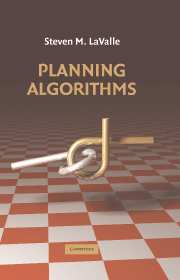Book contents
- Frontmatter
- Contents
- Preface
- I Introductory Material
- II Motion Planning
- 3 Geometric Representations and Transformations
- 4 The Configuration Space
- 5 Sampling-Based Motion Planning
- 6 Combinatorial Motion Planning
- 7 Extensions of Basic Motion Planning
- 8 Feedback Motion Planning
- III Decision-Theoretic Planning
- IV Planning Under Differential Constraints
- Bibliography
- Index
6 - Combinatorial Motion Planning
from II - Motion Planning
Published online by Cambridge University Press: 21 August 2009
- Frontmatter
- Contents
- Preface
- I Introductory Material
- II Motion Planning
- 3 Geometric Representations and Transformations
- 4 The Configuration Space
- 5 Sampling-Based Motion Planning
- 6 Combinatorial Motion Planning
- 7 Extensions of Basic Motion Planning
- 8 Feedback Motion Planning
- III Decision-Theoretic Planning
- IV Planning Under Differential Constraints
- Bibliography
- Index
Summary
Combinatorial approaches to motion planning find paths through the continuous configuration space without resorting to approximations. Due to this property, they are alternatively referred to as exact algorithms. This is in contrast to the sampling-based motion planning algorithms from Chapter 5.
Introduction
All of the algorithms presented in this chapter are complete, which means that for any problem instance (over the space of problems for which the algorithm is designed), the algorithm will either find a solution or will correctly report that no solution exists. By contrast, in the case of sampling-based planning algorithms, weaker notions of completeness were tolerated: resolution completeness and probabilistic completeness.
Representation is important
When studying combinatorial motion planning algorithms, it is important to carefully consider the definition of the input. What is the representation used for the robot and obstacles? What set of transformations may be applied to the robot? What is the dimension of the world? Are the robot and obstacles convex? Are they piecewise linear? The specification of possible inputs defines a set of problem instances on which the algorithm will operate. If the instances have certain convenient properties (e.g., low dimensionality, convex models), then a combinatorial algorithm may provide an elegant, practical solution. If the set of instances is too broad, then a requirement of both completeness and practical solutions may be unreasonable. Many general formulations of general motion planning problems are PSPACE-hard; therefore, such a hope appears unattainable. Nevertheless, there exist general, complete motion planning algorithms.
Information
- Type
- Chapter
- Information
- Planning Algorithms , pp. 206 - 256Publisher: Cambridge University PressPrint publication year: 2006
Accessibility standard: Unknown
Why this information is here
This section outlines the accessibility features of this content - including support for screen readers, full keyboard navigation and high-contrast display options. This may not be relevant for you.Accessibility Information
- 3
- Cited by
